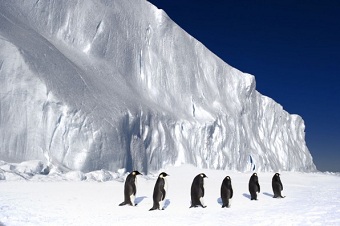Nations Have Historic Opportunity to Protect Antarctic Waters
 When people hear the word “Antarctica,” they might think about penguins or towering icebergs. But the region is more than ice and birds that fly under water – the Southern Ocean makes up 10% of the world’s ocean and is home to almost 10,000 species. This week, 24 governments, including the EU, U.S., New Zealand, Australia, and China, will meet and make decisions that will impact Antarctic marine ecosystems for generations to come. Now is the time for the public to let them know that these amazing places deserve protection.
When people hear the word “Antarctica,” they might think about penguins or towering icebergs. But the region is more than ice and birds that fly under water – the Southern Ocean makes up 10% of the world’s ocean and is home to almost 10,000 species. This week, 24 governments, including the EU, U.S., New Zealand, Australia, and China, will meet and make decisions that will impact Antarctic marine ecosystems for generations to come. Now is the time for the public to let them know that these amazing places deserve protection.The aforementioned countries are members of a management body called the Commission for the Conservation of Antarctic Marine Living Resources (CCAMLR). CCAMLR has agreed to establish a network of Marine Protected Areas or MPAs in the Southern Ocean around Antarctica by 2012. CCAMLR members are considering several proposals for MPAs that would form part of this network. Two regions under consideration are the Ross Sea and East Antarctica, both of which are areas of high ecological significance.
The Ross Sea is one of the world’s last largely undisturbed marine ecosystems. There is broad agreement at CCAMLR that there should be an MPA in the Ross Sea. However, some countries wish to continue fishing there and only support limited protection for some critical ecosystem areas.
Also on the table is a proposal from Australia, France and the EU for an MPA of 1.9 million square kilometres (an area almost three times the size of France) of coastal area in the East Antarctic. This vast region is home to a significant number of the Southern Ocean’s penguins, seals, and whales and contains rare and unusual seafloor and oceanographic features, which support high biodiversity. This proposal will protect many important ecosystems, but excludes several key areas of seamounts (often hotspots for marine life) and areas near Prydz Bay that are important feeding areas for 3 species of seals and a whopping 25 species of seabirds.
Antarctic marine ecosystems are under increasing pressure. Growing global demand for seafood means greater interest in the Southern Ocean’s resources, while climate change and ocean acidification will affect the habitats and abundance of important food sources for penguins, whales, seals, and birds. But decisions about how to protect the Antarctic are made by the countries of CCAMLR without much input from their citizens.
The Antarctic Ocean Alliance, a group of 30 international environmental organizations, including the Pew Environment Group, WWF, Greenpeace, Humane Society International, and the Antarctic and Southern Ocean Coalition, have been working for more than a year to encourage CCAMLR to seize this unprecedented opportunity to establish marine protection in this remarkable region, while we still can.
Over 165,000 people from around the world have signed our petition calling for key Antarctic marine habitats to be protected and to “Joint the Watch” of CCAMLR and what it decides to do this week and next. High-profile Ambassadors for the campaign include actors Leonardo DiCaprio and Edward Norton, oceanographer Dr. Sylvia Earle, entrepreneur Sir Richard Branson, and explorer Jean-Michele Cousteau have joined the call.
You can return to the main Market News page, or press the Back button on your browser.

